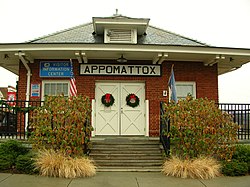
The Richmond–Petersburg campaign was a series of battles around Petersburg, Virginia, fought from June 9, 1864, to March 25, 1865, during the American Civil War. Although it is more popularly known as the siege of Petersburg, it was not a classic military siege, in which a city is encircled with fortifications blocking all routes of ingress and egress, nor was it strictly limited to actions against Petersburg. The campaign consisted of nine months of trench warfare in which Union forces commanded by Lt. Gen. Ulysses S. Grant assaulted Petersburg unsuccessfully and then constructed trench lines that eventually extended over 30 miles (48 km) from the eastern outskirts of Richmond, Virginia, to around the eastern and southern outskirts of Petersburg. Petersburg was crucial to the supply of Confederate Gen. Robert E. Lee's army and the Confederate capital of Richmond. Numerous raids were conducted and battles fought in attempts to cut off the Richmond and Petersburg Railroad. Many of these battles caused the lengthening of the trench lines.

Appomattox is a town in Appomattox County, Virginia, United States. The population was 1,733 at the 2010 census. It is the county seat of Appomattox County.
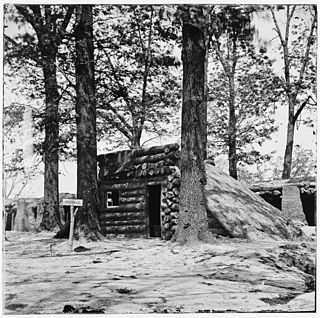
The Battle of Fort Stedman, also known as the Battle of Hare's Hill, was fought on March 25, 1865, during the final weeks of the American Civil War. The Union Army fortification in the siege lines around Petersburg, Virginia, was attacked in a pre-dawn Confederate assault by troops led by Maj. Gen. John B. Gordon. The attack was the last serious attempt by Confederate troops to break the Siege of Petersburg. After an initial success, Gordon's men were driven back by Union troops of the IX Corps commanded by Maj. Gen. John G. Parke.

The Appomattox Court House National Historical Park is a preserved 19th-century village in Appomattox County, Virginia. The village is the site of the Battle of Appomattox Court House, and contains the McLean House, where the surrender of the Army of Northern Virginia under Robert E. Lee to Union commander Ulysses S. Grant took place on April 9, 1865, an event widely symbolic of the end of the American Civil War. The village itself began as the community of Clover Hill, which was made the county seat of Appomattox County in the 1840s. The village of Appomattox Court House entered a stage of decline after it was bypassed by a railroad in 1854. In 1930, the United States War Department was authorized to erect a monument at the site, and in 1933 the War Department's holdings there was transferred to the National Park Service. The site was greatly enlarged in 1935, and a restoration of the McLean House was planned but was delayed by World War II. In 1949, the restored McLean House was reopened to the public. Several restored buildings, as well as a number of original 19th-century structures.

The Battle of Appomattox Court House, fought in Appomattox County, Virginia, on the morning of April 9, 1865, was one of the last battles of the American Civil War (1861–1865). It was the final engagement of Confederate General in Chief, Robert E. Lee, and his Army of Northern Virginia before they surrendered to the Union Army of the Potomac under the Commanding General of the United States Army, Ulysses S. Grant.

The Battle of Sailor's Creek was fought on April 6, 1865, near Farmville, Virginia, as part of the Appomattox Campaign, near the end of the American Civil War. It was the last major engagement between the Confederate Army of Northern Virginia, commanded by General Robert E. Lee, and the Army of the Potomac, under the overall direction of Union General-in-Chief Lieutenant General Ulysses S. Grant.

The Appomattox campaign was a series of American Civil War battles fought March 29 – April 9, 1865, in Virginia that concluded with the surrender of Confederate General Robert E. Lee's Army of Northern Virginia to forces of the Union Army under the overall command of Lieutenant General Ulysses S. Grant, marking the effective end of the war.
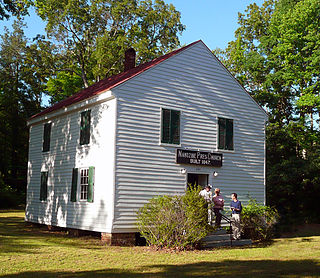
The Battle of Namozine Church was an engagement in Amelia County, Virginia, between Union Army and Confederate States Army forces that occurred on April 3, 1865, during the Appomattox Campaign of the American Civil War. The battle was the first engagement between units of General Robert E. Lee's Confederate Army of Northern Virginia after that army's evacuation of Petersburg and Richmond, Virginia, on April 2, 1865, and units of the Union Army under the immediate command of Maj. Gen. Philip Sheridan, who was still acting independently as commander of the Army of the Shenandoah, and under the overall direction of Union General-in-Chief Lt. Gen. Ulysses S. Grant. The forces immediately engaged in the battle were brigades of the cavalry division of Union Brig. Gen. and Brevet Maj. Gen. George Armstrong Custer, especially the brigade of Colonel and Brevet Brig. Gen. William Wells, and the Confederate rear guard cavalry brigades of Brig. Gen. William P. Roberts and Brig. Gen. Rufus Barringer and later in the engagement, Confederate infantry from the division of Maj. Gen. Bushrod Johnson.
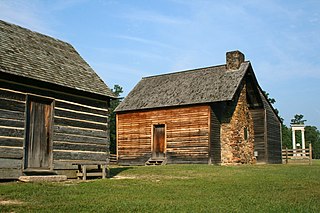
Bennett Place is a former farm and homestead in Durham, North Carolina, which was the site of the last surrender of a major Confederate army in the American Civil War, when Joseph E. Johnston surrendered to William T. Sherman. The first meeting saw Sherman agreeing to certain political demands by the Confederates, which were promptly rejected by the Union cabinet in Washington. Another meeting had to be held to agree on military terms only, in line with Robert E. Lee’s recent surrender to Ulysses S. Grant. This effectively ended the war.

Bryan Grimes was a North Carolina planter and a general officer in the Confederate Army during the American Civil War. He fought in nearly all of the major battles of the Eastern Theater of that war.

The 35th Virginia Cavalry Battalion, also known as White's Battalion, White's Rebels and the Comanches, was a Confederate cavalry unit during the American Civil War raised by Elijah V. White in Loudoun County, Virginia in the winter of 1861-62. The battalion was initially raised as border guards along the Potomac River below Harpers Ferry but were ultimately mustered into regular service as part of the Laurel Brigade. Despite this, they continued to play a conspicuous role in the ongoing partisan warfare in Loudoun throughout the war. The battalion was particularly notable during the 1863 Gettysburg Campaign, when it played a prominent role in the Battle of Brandy Station and subsequently conducted a series of raids on Union-held railroads and defensive positions in Maryland and Pennsylvania. The 35th was the first Confederate unit to enter Gettysburg, Pennsylvania.

Five Forks Battlefield is a battlefield of the American Civil War, the location of the Battle of Five Forks, in which Union Army forces broke through Confederate Army lines, opening the way to gain control of the last rail line to besieged Petersburg. The Confederate loss caused them to abandon that city, which undermined the defense of Richmond, the Confederate capital. Final surrender of the Confederate forces would occur at Appomattox Courthouse eight days later.

Sailor's Creek Battlefield Historical State Park is a 321-acre (130 ha) state park near Rice, Virginia, located mostly in Amelia County with a small portion in Prince Edward County. It includes a portion of the landmarked Sayler's Creek Battlefield, an area of 1,022 acres (414 ha) that was the site of the April 6, 1865 Battle of Sayler's Creek, one of the last major engagements in the Eastern Theater of the war involving Confederate General-in-Chief Robert E. Lee (1807-1870). The battle occurred during his week-long retreat to the southwest in the final Appomattox campaign from the fallen Confederate capital at Richmond and nearby Petersburg, three days before his surrender at Appomattox Court House to Union Army General-in-Chief Ulysses S. Grant (1822-1885), which effectively ended the American Civil War (1861-1865).

The McLean House near Appomattox, Virginia is within the Appomattox Court House National Historical Park. The house was owned by Wilmer McLean and his wife Virginia near the end of the American Civil War. It served as the location of the surrender conference for the Confederate army of General Robert E. Lee on April 9, 1865, after a nearby battle.
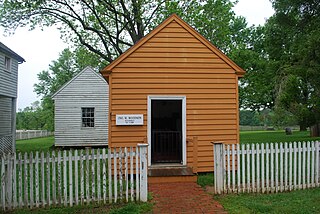
The Woodson Law Office is a structure within the Appomattox Court House National Historical Park. It was originally built by Samuel McDearmon in 1854 and rented by Woodson for his law office until he purchased it a couple of years later. It is a small structure and was built next to the main general store of Appomattox.

The Peers House is a structure within the Appomattox Court House National Historical Park. It was registered in the National Park Service's database of Official Structures on June 26, 1989.

The Bocock–Isbell House is a structure within the Appomattox Court House National Historical Park. It was registered in the National Park Service's database of Official Structures on June 26, 1989.
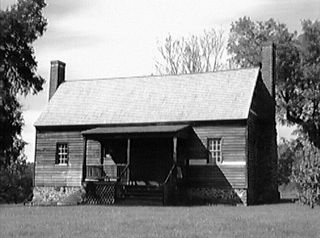
The Mariah Wright house is a structure within the Appomattox Court House National Historical Park. It was registered in the National Park Service's database of Official Structures on June 26, 1989.
Jetersville is a mostly rural unincorporated community in southwestern Amelia County in the U.S. state of Virginia, just off US 360. The town is centered around the intersection of SR 671 and SR 640. The Norfolk Southern Railway runs along the main roads.
The following Confederate States Army units and commanders fought in the final military encounter of the American Civil War, the 1865 Appomattox campaign, which lasted from March 29 to April 9 and resulted in Confederate surrender on April 9 at the Appomattox Court House. Order of battle has been compiled from the army organization during the campaign. The Union order of battle is listed separately.
